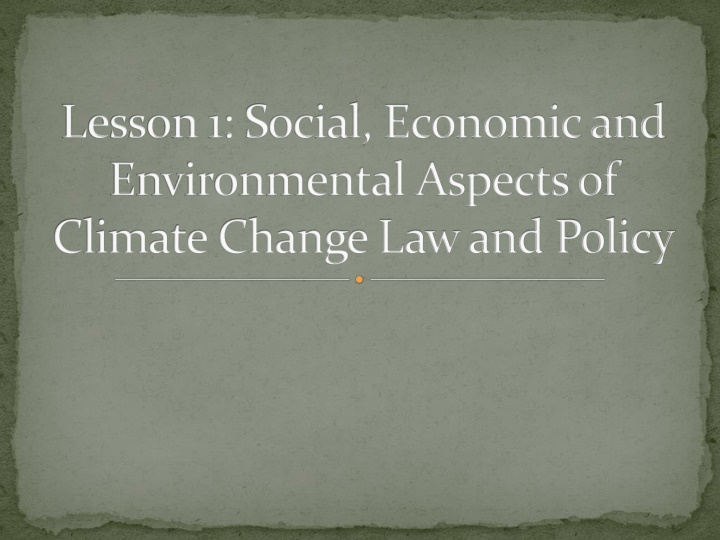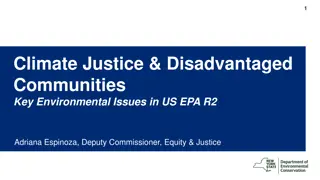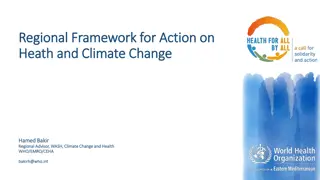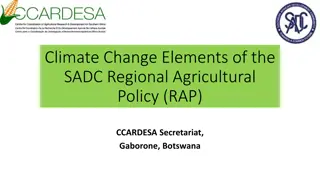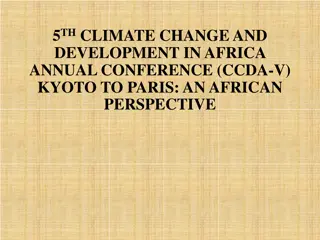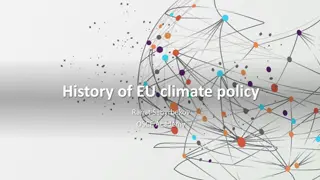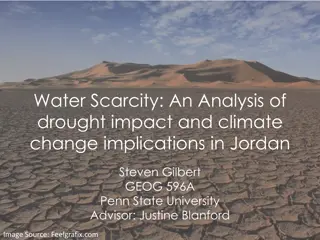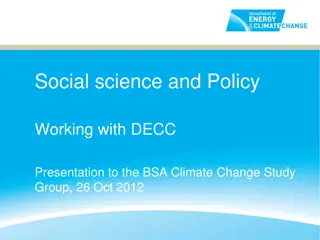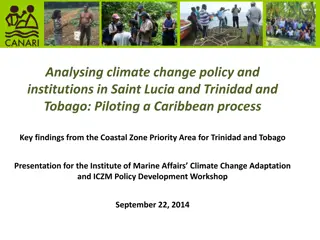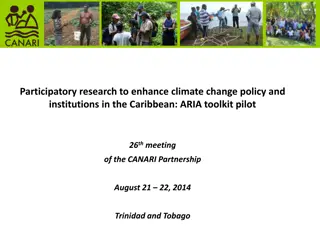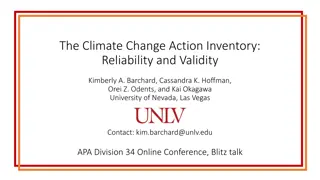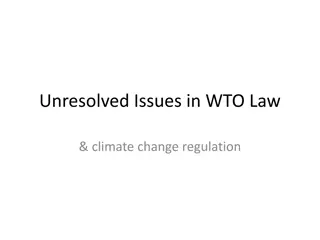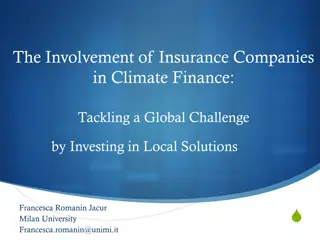Social, Economic, and Environmental Aspects of Climate Change Law and Policy
Climate change refers to the shift in Earth's global climate caused by the greenhouse effect. This phenomenon impacts heat distribution, weather patterns, and more. Greenhouse gases play a crucial role in the greenhouse effect, and human activities have intensified this natural process.
Download Presentation

Please find below an Image/Link to download the presentation.
The content on the website is provided AS IS for your information and personal use only. It may not be sold, licensed, or shared on other websites without obtaining consent from the author.If you encounter any issues during the download, it is possible that the publisher has removed the file from their server.
You are allowed to download the files provided on this website for personal or commercial use, subject to the condition that they are used lawfully. All files are the property of their respective owners.
The content on the website is provided AS IS for your information and personal use only. It may not be sold, licensed, or shared on other websites without obtaining consent from the author.
E N D
Presentation Transcript
Lesson 1: Social, Economic and Environmental Aspects of Climate Change Law and Policy
Lesson 1A: What is Climate Change? When we speak of climate change on a global scale, we are referring to changes in the climate of the Earth as a whole. This phenomena was once called global warming , but global climate change is the more accurate term. It refers to an overall shift in the global climate of the Earth. This shift is caused the greenhouse effect. The green house effect is the phenomenon by which the sun s energy, in the form of radiation, is trapped in our atmosphere by particles of water and gases (commonly called the greenhouse gases, as explained below) that collect and create a shield which blocks heat from escaping.
Lesson 1A: What is Climate Change? This warming of the air and the Earth s surface leads to changes in heat distribution which in turn affect heat related phenomenon such as weather, water distribution, precipitation, wind patterns, etc. When the energy budget (overall heat retention) of the planet is modified, it has an impact on the overall climate. Climate change is a change in the average weather that a given region experiences. Scientists estimate that, at the present rate, greenhouse gases could lead to the Earth s temperature increasing by 1 C to 3.5 C. This might not seem much, until we consider that the difference between an ice age and the climate that we currently enjoy is a mere 2 C to 3 C, on a global level.
Lesson 1B: Greenhouse Gases and Their Effects The Greenhouse Effect The greenhouse effect is an important phenomenon that affects the global climate of the planet. The temperature of Earth is determined by the balance between the flux of incoming radiation from the sun and the amount of outgoing infrared radiation reverted back into space. This balance is what regulates the temperature on the Earth. On entering the Earth s atmosphere, solar radiation is either absorbed or scattered. Clouds, atmospheric gases and aerosols are responsible for the scattering and absorption of solar radiation. The amount of radiation absorbed is added to the planet s heat budget. If more radiation is entering than leaving, slowly the global temperature increases and this leads to an enhanced greenhouse effect.
Lesson 1B: Greenhouse Gases and Their Effects Greenhouse Gases A greenhouse gas (GHG) is a gas that has the ability to block the radiation going out (of a specific wavelength) and thus contributes to the greenhouse effect. The main greenhouse gases are water vapour (H20), carbon dioxide (CO2), methane (CH4), nitrous oxide (N2O), ozone (O3), and halocarbons (CFCs, HFCs, etc.). Without these greenhouse gases, the sun's heat would escape and the average temperature of the earth would be 33 degrees cooler (-18 C) too cold to support life as we know it. Human activities have resulted in the release of significant quantities of greenhouse gases, which remain in the atmosphere for long periods of time. This intensifies the natural greenhouse effect. Basically, human activities are tinkering with the Earth s energy budget.
Lesson 1B: Greenhouse Gases and Their Effects Carbon Dioxide in Particular? Carbon dioxide (CO2) is the most important of the greenhouse gases released by human activities. This is done mainly through the burning of fossil fuels for energy production. It is the principal contributor to climate change, due to the quantities released. When fossil fuels are burned, the carbon content is oxidized and released as carbon dioxide; every tonne of carbon burned produces 3.7 tonnes of carbon dioxide. The global consumption of fossil fuels is estimated to release 22 billion tonnes of carbon dioxide into the atmosphere every year. Other greenhouse gases are also significant contributors. Methane is produced naturally when vegetation is burned, digested or rotted without the presence of oxygen. Large amounts of methane are released by garbage dumps, rice paddies and grazing cattle. Methane is significant because it has 21 times the heat- trapping effect of carbon dioxide. Nitrous oxide is also another important GHG, although it occurs naturally in the environment, human activities are increasing significantly its quantities in the atmosphere. Nitrous oxide is released when chemical fertilizer is used in agriculture.
Lesson 1C: Environmental Implications of Climate Change Increasing temperatures will lead to changes in many aspects of weather, such as wind patterns, the amount and type of precipitation, and the types and frequency of severe weather events that may be expected to occur. The global sea level could rise due to several factors including melting ice and glaciers. Rising sea levels could damage coastal regions through flooding and erosion. The climate of various regions could change too quickly for many plant and animal species to adjust. Harsh weather conditions, such as heat waves and droughts, could also happen more often and more severely. The rate and magnitude of global climate changes over the long term have many implications for natural ecosystems and all life forms. Such a rise in the planet s heat budget is expected to trigger a chain of events which are likely to be predominantly negative. Potential problems include increased incidence of forest fires, reduced crop yield, decreased water availability, more insect infestations, increased incidence of diseases, increased energy demands for cooling, and other impacts.
Lesson 1D: Social implications of climate change Climate change could also affect the health and well-being of Canadians. Many larger cities could experience a significant rise in the number of very hot days. Canadian water resources could be damaged by flooding and high sea levels. General air pollution problems could also increase, placing children, the elderly and people suffering from respiratory problems at greatest risk of health effects, while increases in local air pollution could result in increased deaths. Increases in moulds and pollens due to warmer temperatures could also cause respiratory problems such as asthma for some people, particularly those with hay fever or allergies. Several diseases are expected to spread to areas where they have not occurred before, leading to an increase in medical care costs. Over the longer term, it is possible that climate change could affect food security due to modifications of weather patterns and hence possibilities for farming in many countries, including Canada, and water quality could also be affected, with attendant health effects.
Lesson 1E: Economic implications of climate change The extent to which human systems will suffer economically from climate change depends on the adaptive capabilities within a region as well as across regions. It is difficult to measure the economic implications of climate change with accuracy. However, most authors agree to say that the food production sector will be the most affected. As agriculture and fisheries are two major economic revenues for Canada and several other countries in the world, the economic impact of those sectors could be extremely serious.
Lesson 1E: Economic implications of climate change Other industries can also be affected, primarily those industries relying on natural resources, such as timber industries. Changes in plant productivity and distribution of certain regions are to be expected but there is no consensus as to how the complex dynamic processes of production may be affected, and the full economic impact of these changes. The economic sectors which support the timber, agricultural and fisheries industries would also be affected, due to changes in resource productivity or changes in market demand for the goods and services produced.
Lesson 1E: Economic implications of climate change Some aspects of physical infrastructure (including energy transmission and distribution systems), buildings, urban services (including transportation systems), and specific industries (such as agro- industry, tourism, and construction) may also be directly affected.
Lesson 1F: Cost Estimates of Climate Change Implications The costs of ordinary and extreme weather events have increased rapidly in recent decades. The United Nations Framework Convention on Climate Change s Intergovernmental Panel on Climate Change has estimated that global economic losses from catastrophic events increased 10.3-fold from 3.9 billion US$/yr in the 1950s to 40 billion US$/yr in the 1990s, with approximately one-quarter of the losses occurring in developing countries. As a result, insurance policies have increased; casual insurance premiums for weather related losses fell by a factor of three between 1985 and 1999.
Lesson 1G: Specific Implications for Canada Of particular importance to Canada, the Intergovernmental Panel on Climate Change has observed that climate change will likely be most extreme in the polar regions. The temperature is expected to rise at an average of 8 C, this could lead to changes in ice patterns, preventing polar bears from gaining access to their food source, mainly seals. Malnourished bears will then wander into towns and isolated communities for food, and high mortality may also result. For aboriginal peoples living in the North, traditional lifestyles will be upset by changes in the distribution and abundance of wildlife in the region. The sovereignty of Canada over its arctic regions is also likely to be questioned as the ice in the North West passage melts and shipping becomes possible. Moreover, Canadians working in climate-sensitive sectors such as fisheries, forestry, energy and agriculture will face new and increased challenges and uncertainties.
Lesson 1H: What is the Current State of Technology and How Does this Affect Outcomes? Global warming and climate change have become an important concern for sustainable development. Many governments are taking steps to reduce GHG emissions through national policies and laws. These include measures such as the introduction or strengthening of: emissions trading programs [whereby total allowable emissions are capped or permitted, then companies that can reduce cheaply are able to trade their emission reductions to companies that would have to spend much more to achieve less reductions], voluntary emission reduction and energy efficiency programs [whereby companies make a voluntary commitment to act, or governments convince consumers / industry groups to act using subsidies, financial incentives, or education, or NGOs undertake voluntary agreements with companies to act], carbon or energy taxes [whereby governments charge companies or consumers for emissions levels beyond a certain allowable limit , target or cap], other regulations and standards on energy efficiency and emissions.
Lesson 1H: What is the Current State of Technology and How Does this Affect Outcomes? Companies and other consumers must be able to understand and manage their GHG risks. In particular, companies need to be able to measure their GHGs if they are to ensure long-term success in a competitive business environment, and to be prepared for future national or regional climate policies. In many countries, large industrial emitters are working to develop new technologies to allow them to cope with the increased costs of doing business, once new laws and reduction requirements are imposed. Under new obligations, a switch to cleaner technologies becomes more economically viable as the costs of emitting GHGs is internalized by the companies and products that are energy-intensive.
Lesson 1H: What is the Current State of Technology and How Does this Affect Outcomes? Low-impact renewable energy is the fastest-growing form of energy in the world. Although these sources and technologies currently take a back seat in Canada to more traditional energy industries such as oil and gas, Canada s key trading partners and several of the world's largest multinationals are investing hundreds of millions of dollars in low-impact renewable energy to prepare for the coming change in global energy markets.
Lesson 1I: Emissions Trading The term emissions trading refers to a market created for emissions permits, in which parties can buy or sell allowances for emissions, or credits for reductions in emissions of specified GHGs. Emissions trading can work regionally or globally. Businesses, governments and voluntary groups can all participate in emissions trading. As with any market, emissions trading requires many buyers and sellers to come together to trade a commodity, which in this case is emissions allowances or permits or emissions reduction credits. Experts consider emissions trading to be an important potential means of minimizing the costs of reducing global emissions of greenhouse gases. International, national and provincial emissions trading systems are especially relevant for Canada, which faces a considerable challenge in meeting its international commitments to reduce its large and growing emissions of greenhouse gases.
Lesson 1I: Emissions Trading How does emissions trading work? At the beginning of an emissions trading program, emitters are allocated a limited amount of emissions. The sum of the permits corresponds to the overall emissions target of the covered sources. Emitters that reduce their emissions below their permitted levels can sell their unused permits to companies that are emitting above the level they are allowed. For some emitters, it may be cheaper to buy at least some unused permits than to make investments (in new equipment, technologies, etc.) to reduce the emissions themselves.
Lesson 1I: Emissions Trading If governments reduce the total number of permits in circulation, over time the market for unused permits will become increasingly expensive, and more excessive emitters will find that developing cleaner means of production is a cheaper alternative. In some instances, it may even pay for investors or owners to shift away from polluting technologies completely. In the meantime, overall emissions will have been reduced, and innovative emitters will have profited from selling unused permits. Emissions trading systems can provide time for companies to modernize operations, as well as economic incentives for cleaner industries. For example, if an emissions trading scheme has a five-year time frame, companies can invest in cleaner technologies within this period as they renew their capital stock.
Lesson 1I: Emissions Trading The costs of controlling greenhouse gas emissions, it is thought, can be significantly reduced with emissions trading. Some economists affirm that where relative costs of performing an activity differ among individuals, business firms or regions, there are almost always potential gains from trade. Other groups disagree with this approach, arguing that trading systems can delay development of new technologies and allow large emitters to buy their way out of cleaning up their production techniques.
Lesson 1 Summary In this Lesson, you learned about the scientific bases of climate change. You learned the ways in which climate change impacts on the environment, society, and the economy. You also learned the specific impacts of climate change on Canada.
